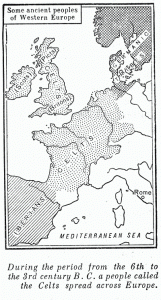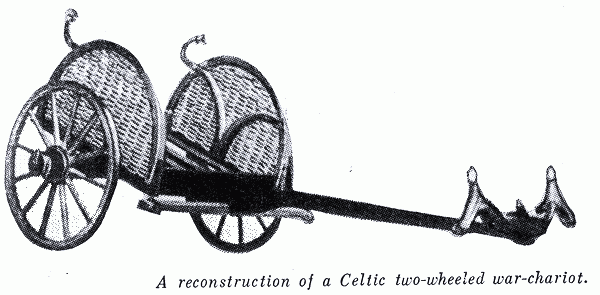The Celts
Category: 00 Early periodDuring the period from the 6th to the 3rd century В. C. a people called the Celts spread across Europe from the east to the west.
 More than one Celtic tribe invaded Britain. From time to time these tribes were attacked and overcome by other Celtic tribes from the Continent. Celtic tribes called the Piets penetrated into the mountains on the North; some Piets as well as tribes of Scots crossed over to Ireland and settled there. Later the Scots returned to the larger island and settled in the North beside the Piets. They came in such large numbers that in time the name of Scotland was given, to that country. Powerful Celtic tribes, the Britons, held most of the country, and the southern half of the island was named Britain after them. Today the words “Briton” and “British” refer to the people of the whole of the British Isles.
More than one Celtic tribe invaded Britain. From time to time these tribes were attacked and overcome by other Celtic tribes from the Continent. Celtic tribes called the Piets penetrated into the mountains on the North; some Piets as well as tribes of Scots crossed over to Ireland and settled there. Later the Scots returned to the larger island and settled in the North beside the Piets. They came in such large numbers that in time the name of Scotland was given, to that country. Powerful Celtic tribes, the Britons, held most of the country, and the southern half of the island was named Britain after them. Today the words “Briton” and “British” refer to the people of the whole of the British Isles.
The Iberians were unable to fight back the attacks of the Celts who were armed with metal spears, swords, daggers and axes. Most of the Iberians were slain in the conflict; some of them were driven westwards into the mountains of what is now Wales and the others probably mixed with the Celts.
We know more about the Celts than about the earlier inhabitants of the island, because of the written accounts that exist.
The Celts did not write down the events themselves. Other peoples who knew them described them in their books.
The Greeks were the first to mention the British Isles. It is from the Greek books that we know about the Phoenicians, who were great sailors and traders even before the Greeks and who travelled as far as the shores of Britain.
The ancient Greek historian Herodotus who is called the Father of History wrote that in the 5th century В. C. the Phoenicians used to come to the British Isles for tin which was used in making bronze. They called the British Isles the Tin Islands.
The earliest writer from whom we have learned much about the country and its inhabitants was Julius Caesar, the famous Roman general, statesman and writer. In his Commentaries on the Gallic War? a book written in Latin, Julius Caesar describes the island and the Celts against whom he fought. He tells us that the Celts were tall and blue-eyed. They wore long flowing moustaches but no beards. In their mode of life the British Celts differed little from the Celtic tribes of the Gauls who lived on the Continent. In the 1st century В. C. they lived in tribes, and were ruled by chiefs whom all the tribesmen obeyed. The chiefs were military leaders and some of them were very powerful. The military leaders of the largest tribes were sometimes called kings and stood at the head of detachments of warriors.
The Celts had no towns; they lived in villages. They were acquainted with the use of copper, tin and iron and they kept large herds of cattle and sheep which formed their chief wealth. They also cultivated crops, especially corn. They used light ploughs as well as hoes, and grew their crops in small, square fields. The Celtic tribes of the Britons who inhabited the south-eastern parts of the island were more civilized than the other tribes. Their clothing was made of wool, woven in many colours while the other Celts wore skins.
Some of the Celtic tribes were quite large and fighting was common among them. In war-time the Celts wore skins and painted their faces with a blue dye to make themselves look fierce. They were armed with swords and spears and used chariots on the battle-field. Their war-chariots were made of wicker and scythes of bronze were attached to the wooden wheels. These were drawn by two or four horses, and were large enough to hold several persons in each. Caesar writes that the Celts charged fiercely in the battle. Standing in their chariots, they rushed along the enemy’s lines, waving their spears and uttering loud cries and driving the scythes against all who came within reach.
The Celts worshipped Nature. They imagined the sky, the sun, the moon, the earth and the sea, to be ruled by beings like themselves, but much more powerful. Sometimes the same pagan gods in various places were called by different names. Besides these they had many lesser gods and the gods of one tribe were often quite unknown to the other tribes. They also believed in many nameless spirits who lived in the rivers, lakes, mountains and thick forests. They sacrificed not only animals, but also human beings to their gods. Sometimes these victims were placed into a great wicker basket and burnt, sometimes they were slain with knives. The Celts believed in another life after death. They were taught by priests called druids that their souls passed after death from one body to another. The druids lived near groves of oak-trees which were considered to be sacred places. No one was allowed to come near without permission. The druids were very important and powerful, sometimes, more powerful than the chiefs. The Celts believed in their magic power. They believed that the druids were able to foretell the future and the druids very often acted as prophets. The tribesmen often called upon the druids to settle disputes. The druids could give orders to begin a battle or to put down arms and stop fighting. The druids were also teachers and doctors for they were wiser than the other tribesmen. Wise women were also considered to be very important. There were women prophets, and women warriors who trained young men in arms; some women were made tribal chiefs and called queens.
The old Celtic legends tell us about the woman warrior Scathach who taught young men all her war-craft. She lived on a far-away island in the east of Scotland. It was hard to reach Scathach’s Island and to become her pupil. The famous hero of the Celtic legends, Cuchulainn, had to overcome many difficulties in his way to the island of the warrioress. Here is how the legend goes. “The road lay across the Plain of Bad Luck, where men’s feet stuck fast, while sharp grasses sprang up and cut them. When Cuchulainn crossed the plain, he had to go through the Glen of Danger, which was full of monsters, and after that he had to go over wild mountains. At last he reached the place where the pupils of Scathach were assembled. He asked where Scathach was.
‘On the island there,’ they replied. How may I get to it?’ he asked.
‘Across the Bridge of the Pupils,’ said they.
But it was not easy to cross the bridge; the two ends of it were low and the middle high, and when anyone put his foot on one end of it the other end rose and threw him over backwards. Cuchulainn, not knowing this, jumped on to the bridge and was immediately thrown back on to the ground among the pupils, who roared with laughter at him. Again he tried, but with no more success, and a third time with greater effort he tried, but was again thrown back. Then anger came into his heart, and a magic halo shone round his head, and he jumped on to the middle of the bridge, and reached the other end before it could rise to throw him back.
Cuchulainn went to Scathach, and put his sword to her breast, and threatened to kill her if she did not teach him all she knew. So he became her pupil, and she taught him all her war-craft. She also taught him how to use the terrible spear that no one else could use. No living man could overcome Cuchuiainn now.”

